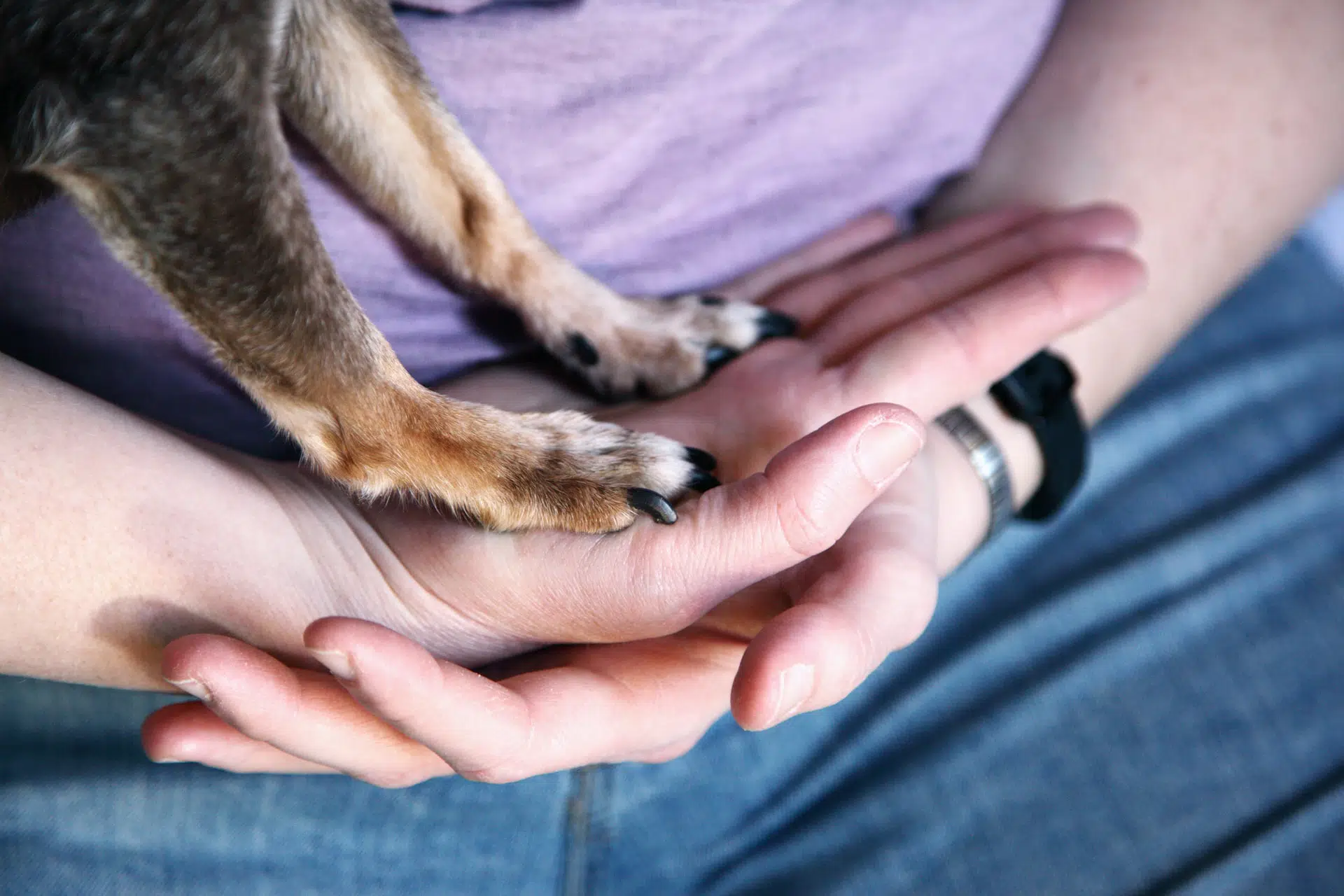Dogs spend most of their time on their feet, and that is why you need to take good care of your pet’s paws. They are already made to endure a lot of hardship, but that doesn’t mean there will be no issues throughout the course of your dog’s life.
Every responsible dog owner should be well informed on the topic of dog paw problems. In this way, they’ll be able to prevent – or at least recognize – a problem early on and resolve it before it becomes too severe or debilitating.
Protect those precious paw pads at all costs!
Most Common Dog Paw Problems: Symptoms & Treatment

Most dog owners fail to check their buddy’s paws daily. For this reason, it becomes relatively easy to overlook paw problems and treat them early on.
The sooner you act, the sooner you’ll resolve the issue and help your dog be happy and active as ever before. That’s reason enough to keep reading!
How To Tell That Your Dog Has Paw Problems?

Your dog wants you to be happy as much as you want that for them. That’s why many of our furry friends deal with problems stoically – and try not to show that something’s troubling them.
And as a result, some dog owners find out that their pet has an issue only when it becomes too severe to hide.
It would be best to pick up on initial signs that your pup is bothered by its paws.
So, here’s a detailed list of early symptoms of dog paw problems:
- Licking or chewing of paws
- Discoloration of the fur on the paws that shows the dog has been licking them (even if you haven’t noticed it yet)
- Swollen dog paws
- Cracked paw pads
- Hair loss around the dog’s paws
- Itchy skin in the paw area
- Holding the affected foot up
- Limping
- Paw bleeding
- Red toes
- Redness between the toes
- Ulcers or lesions
- Discharge
Examine your pup’s paws as soon as you notice any of these symptoms. If your dog does not allow you to do that, it’s probably too painful – and you might want to leave it to the professional.
Schedule an appointment with your dog’s vet as soon as possible to have your pup’s paw examined. The vet will determine the causes – and set the best course of treatment.
Most Common Causes Of Dog Paw Problems

Allergic Reactions
Allergies are the number one reason for dog paw problems. The symptoms of an allergic reaction include:
- Itching between and underneath toes
- Pain in the affected paw
- Inflammation
- Redness between the toes and paw pads
Besides dogs paws, signs of allergies can manifest as watery eyes, a runny nose, and sneezing.
How To Tell Your Dog Is Having An Allergic Reaction?
If your dog is licking the paws and chewing its toes, chances are the reason for that is allergies. It would be best if you reacted quickly to prevent complications.
Consult your dog’s vet for a proper diagnosis. The vet will determine whether your dog suffers from allergies based on your input and a detailed physical exam.
The usual procedure includes taking a small sample of cells from the surface of the dog’s paw. The sample is then observed under a microscope to eliminate other possible causes.
If your dog isn’t a big fan of trips to the vet, you can try an at-home allergy test.
On that note, I highly recommend the 5Strands Pet Test for Dogs.
How To Treat Allergies?
The treatment is often based on medications that alleviate your dog’s pain, discomfort, and itchiness. Vets tend to prescribe special medicated wipes you can use on your pet’s paws and paw pads a couple of times a day, too.
If you think your dog licking paws or paw pads are signs of environmental allergies, you can help by wiping off your dog’s paws every time you come inside. You can use a damp towel or a rag. That way, you’ll remove pollen and other allergens that stick to your pet’s fur and contribute to the problem. And if you suspect food allergies, dietary changes might do the trick.
The main problem is that your pet is always “barefoot” when outside.
Your dog’s paws are constantly touching the ground or hot pavement and picking up all sorts of substances, aggravating allergy symptoms.
Yeast Infections
Every dog has some yeast organisms on its skin; the problem occurs when the yeast starts to overgrow and multiply abnormally.
This type of infection is a common problem in dogs. Whenever there’s an inflammation in your dog’s paws, yeast will “jump at the opportunity” and make things even worse.
How To Tell Your Dog Has A Yeast Infection?
There’s usually a unique foul, yeast-like odor spreading from your dog’s paws – and it’ll be hard to miss. That said, the other symptoms include:
- Discoloration of dog’s nails
- Redness
- Hair loss
- Brown discoloration of your dog’s fur
- Excessive licking of the affected area
- Moist skin in between your dog’s paws
Once again, I advise you to leave the diagnosis to the professionals and take your pet to the vet. The vet will take a sample of the cells between your dog’s toes to confirm the presence of yeast organisms.
How To Treat A Yeast Infection?
Yeast infections are always treated with anti-fungal medication. Your vet will decide if your dog should have an oral treatment or topical creams. Either way, your dog will most probably receive medication to help alleviate the itch.
The treatment usually works fast – and your dog should feel much better in no time.
Bacterial Infection
Bacterial infections are similar to yeast infections in the sense that they, too, are often caused by the normal bacteria living on your dog’s skin. The havoc begins when bacteria start to overpopulate.
If you notice infected paw injuries or bleeding, foul-smelling cuts, go to your vet ASAP.
How To Tell Your Dog Has A Bacterial Infection?
The usual symptoms are:
- Swelling
- Redness
- Foul-smell
- Discharge
- Licking of the affected area
Taking your dog to the vet is, once again, the best course of action. The vet will most likely take a small sample of the discharge from your dog’s pads; the goal is to determine what type of bacteria is causing the problem.
Once that is established, the bacterial culture will be sent out to ensure your dog receives the correct antibiotics to battle the infection.
How To Treat A Bacterial Infection?
Antibiotics are the most common treatment for any infection. The vet will usually recommend putting an e-collar on your dog, too, to prevent them from spreading the infection on other pets.
And if your dog’s in pain, they’ll get pain medications, too.
Foreign Objects
Foreign objects are the cause of most common dog paw problems.
Dog’s feet are rather sensitive – especially dog paw pads. And when something gets stuck in dog paws, such as a splinter, broken glass, or a nail, you may notice that your dog’s limping and favoring one paw over the other.
That’s usually a clear sign of paw pad trauma caused by a foreign object.
How To Tell Your Dog Has Problems Due To Foreign Objects?
Usually, all it takes is a visual inspection, but your vet can order an X-ray – or even ultrasound – of your dog’s paw, too. If these diagnostic methods cannot help locate the foreign object, your dog might undergo a so-called “exploratory surgery.”
How To Treat Injuries Caused By It?
Sharp objects have to be removed. Sometimes, that’s easy, and you can do it at home, but I’d still recommend leaving this job to professionals. Your vet is the only one who can determine if your pet needs surgery – and the only one who can perform it.
Pet owners can prevent these issues by using protective dog boots or dog socks. Of course, dog booties provide better protection.
Torn Nails Or Fractured Nail Bed
Problems with the dog’s toenails are pretty common, too.
When a dog’s nail gets caught in fabric or carpet, it could easily get torn. It usually happens to the toenail called dewclaw, located higher up on your dog’s leg. This claw is allocated on the side and hangs loose – that’s why it’s at a high risk of getting torn. With age, they become more fragile and prone to these fractures, so pay attention to them.
How To Tell If Your Dog Has A Torn Or Fractured Nail?
Visual inspection is all it takes to diagnose an issue with your dog’s nails; you’ll spot the problem easily.
How To Treat Torn Or Fractured Nails?
Try to prevent the problem by cutting long toenails. If your dog still gets a torn nail or an injured nail, visit the vet. Your vet will assess the degree of the tear and use hemostats to pull off the loose toenail quickly.
If the toenail is still firmly attached, the vet can trim it as far as possible and apply a light bandage to protect the paw, keep it clean, and prevent dog licks. Your dog might receive pain medications, as well.
Ingrown Toenails
If you allow your dog’s nails to grow too long, you might have to deal with ingrown nails. Long dog’s nails curl around and can sometimes puncture your pet’s digital pads. It typically happens to the dewclaw because it’s never in contact with the ground or any rough surfaces.
How To Tell If Your Dog Has Ingrown Nails?
Once again, all it takes is a visual inspection. Look for a curved toenail, and see if there’s a tip stuck inside a paw pad – or turn to your vet for help. It’s worth noting that the problem is more common for small and elderly dogs.
How To Treat Ingrown Nails?
Check your dog’s paws regularly and cut the toenails. If the nail is already curved, let the vet take care of the matter.
Your dog might receive antibiotics to prevent (or treat) the potential infection and pain meds might be prescribed, as well.
Toe Fractures
It happens rarely – but dogs do sometimes break their toes. It’s usually a result of an accident.
How To Tell Your Dog Has A Toe Fracture?
If your dog avoids putting weight on a particular paw or you notice it’s swollen, your pup might have a toe fracture. If you want to be 100% sure, you’ll need to take your furry friend in for an X-ray.
Similar reading: Dog face Swollen – Should You Be Worried?
How To Treat Toe Fractures?
It all depends on the location of the fracture. Most of the time, a splint or a thick bandage does the job. The healing of the fracture can take about 8-12 weeks, though.
You’ll have to change the bandages regularly and try to keep your pet as calm as possible during the healing process.
Burns
Your dog’s paw pads are sensitive. It would help if you tried to keep your pet away from hot surfaces such as hot pavement, freezing surfaces, and chemicals.
Dogs run everywhere, I know. So, if you can’t control your pooch, at least check their paws during and after every outing for signs of burns or irritations.
How To Tell If Your Dog Has Paw Pad Burns?
Perform a visual inspection of your dog’s paw pads and look for anything resembling cracked dog paws:
- Blisters
- Red patches
- Loose skin flaps
- Cracked paw pads
How To Treat Burns?
Allow your dog to rest as much as possible. Avoid dog walks on rough terrain, and stay away from hot surfaces and cold weather.
You can try applying some Vaseline to the dog’s paw pads. However, if the burns are too severe, consult your veterinarian and see if your dog needs antibiotics or any other treatment.
Paw Pad Injuries
Injuries are arguably one of the most common dog paw problems. Our canine friends often get cuts, abrasions, and lacerations on their paws, especially when they run outside, over rough terrain.
How To Tell If Your Dog Has Paw Injuries?
If you see bleeding foul-smell cuts, or refusal to walk, always take your dog to the vet. Injuries can upset your dog, and the vet can give them a light sedative to calm down.
How To Treat Injuries?
If cuts aren’t that deep, you can disinfect the injury and apply a light bandage over it. Consult your vet if the dog needs antibiotics, pain medications, or stitches, though.
Cancerous & Non-Cancerous Growths
Dogs can develop growths on their paws – and even though most are benign in nature, they could affect your dog’s health. The malignant (as in, bad) cancers are rare but possible.
On that note, different types of “bad cancers” can affect the dog toes, the most common ones being:
- Squamous Cell Carcinoma
- Malignant Melanoma
How To Tell If Your Dog Has Cancerous Or Non-Cancerous Growths?
Go to the vet if you notice an unusual growth on your dog’s paws, paw pads, or in between their toes. They’ll take a “cytology sample” of the growth to see if it’s benign or malignant.
If the vet cannot determine the diagnosis, your dog might have to be sedated for the biopsy procedure. Sometimes, the vet has to remove the entire growth for a complete diagnosis.
How To Treat Growths?
If the growth is a benign tumor, you can let it be – if it’s not causing any discomfort, that is – or have it removed surgically. The latter option is better since tumors usually continue to grow and cause even more discomfort for your pooch.
If you’re dealing with a bad type of cancer, your vet will probably suggest surgery, amputation of the affected toe, or chemotherapy.
Autoimmune Conditions
Some autoimmune conditions such as Lupoid Onychodystrophy affect a dog’s toes, too. The toenails can:
- Break
- Crack,
- Fall out
Some dog breeds, such as German Shephard Dogs, are more prone to it, but all dogs could develop it.
How To Tell If Your Pup Has An Autoimmune Condition?
Only your vet can make the diagnosis after a thorough physical exam, your description of the problem, and sometimes a biopsy of the affected area.
How To Treat Autoimmune Conditions?
Once diagnosed, the condition lasts a lifetime; medications can only help keep it under control.
The treatment might vary, but it usually consists of proper nail maintenance and several medications, such as:
- Vitamin E
- Omega-3 fatty acids
- Niacinamide
- Steroids (i.e. prednisone)
- Pentoxifylline
- Antibiotic called Doxycycline (for secondary infections)
My Final Thoughts On Paw Problems

I hope you realize how crucial it is to check your dog’s paws daily and make sure they’re healthy. Your best friend depends on you for that!
And, as always:
If you notice anything unusual, contact your vet ASAP. Don’t wait for dog paw problems to get out of hand!



